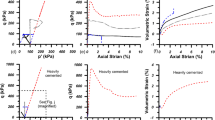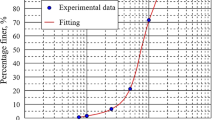Abstract
Microbially induced calcite precipitation (MICP) through the bio-stimulation approach is a promising ground improvement technique that can improve the engineering performance of calcareous sand. This study investigated the shear response of bio-cemented calcareous sand (with 16.2% and 54.6% initial relative density) treated by bio-stimulated MICP. The calcareous sand samples, prepared at two initial relative densities, were firstly subjected to the enrichment and cementation treatment to gain various cementation levels. Biochemical parameters including viable cell number, urea and ammonium concentration, and cementation content were measured during the two stages. The direct shear tests were then conducted at five different normal stresses, and the peak stress ratio, cohesion intercept, peak dilation angle, and stress-dilatancy relationship were obtained. The Mohr–Coulomb linear and bilinear failure envelopes were adopted to obtain the shear parameters. The results were further substantiated by microstructural observations. Finally, a conceptual framework was proposed to analyze the peak state shear behavior of bio-cemented calcareous sand. The interdependence between external influential factors (cementation level, initial relative density, and normal stress) and strength components (interparticle friction, interlocking (dilatancy), particle rearrangement, interparticle bonds and particle crushing) at the peak state were discussed in detail.



















Similar content being viewed by others
References
Amini Kiasari M, Pakbaz MS, Ghezelbash GR (2019) Comparison of effects of different nutrients on stimulating indigenous soil bacteria for biocementation. J Mater Civ Eng 31(6):04019067
Amini Kiasari M, Pakbaz MS, Ghezelbash GR (2018) Increasing of soil urease activity by stimulation of indigenous bacteria and investigation of their role on shear strength. Geomicrobiol J 35(10):821–828
Amini Y, Hamidi A, Asghari E (2014) Shear strength–dilation characteristics of cemented sand–gravel mixtures. Int J Geotech Eng 8(4):406–413
Azadi M, Ghayoomi M, Shamskia N, Kalantari H (2017) Physical and mechanical properties of reconstructed bio-cemented sand. Soils Found 57(5):698–706
Boon M, Rickard WD, Rohl AL, Jones F (2020) Stabilization of aragonite: role of Mg2+ and other impurity ions. Cryst Growth Des 20(8):5006–5017
Cheng L, Cord-Ruwisch R (2013) Selective enrichment and production of highly urease active bacteria by non-sterile (open) chemostat culture. J Ind Microbiol Biotechnol 40(10):1095–1104. https://doi.org/10.1007/s10295-013-1310-6
Cheng L, Cord-Ruwisch R, Shahin MA (2013) Cementation of sand soil by microbially induced calcite precipitation at various degrees of saturation. Can Geotech J 50(1):81–90
Consoli NC, Heineck KS, Casagrande MDT, Coop MR (2007) Shear strength behavior of fiber-reinforced sand considering triaxial tests under distinct stress paths. J Geotech Geoenviron Eng 133(11):1466–1469
Cui MJ, Zheng JJ, Zhang RJ, Lai HJ, Zhang J (2017) Influence of cementation level on the strength behaviour of bio-cemented sand. Acta Geotech 12(5):971–986
Dai BB, Yang J, Zhou CY (2016) Observed effects of interparticle friction and particle size on shear behavior of granular materials. Int J Geomech 16(1):04015011
DeJong JT, Mortensen BM, Martinez BC, Nelson DC (2010) Bio-mediated soil improvement. Ecol Eng 36(2):197–210
Dorich RA, Nelson DW (1983) Direct colorimetric measurement of ammonium in potassium chloride extracts of soils. Soil Sci Soc Am J 47(4):833–836
Douglas LA, Bremner JM (1970) Extraction and colorimetric determination of urea in soils. Soil Sci Soc Am J 34(6):859–862
Feng K, Montoya BM (2016) Influence of confinement and cementation level on the behavior of microbial-induced calcite precipitated sands under monotonic drained loading. J Geotech Geoenviron Eng 142(1):04015057
Gat D, Ronen Z, Tsesarsky M (2016) Soil bacteria population dynamics following stimulation for ureolytic microbial-induced CaCO3 precipitation. Environ Sci Technol 50(2):616–624
Gomez MG, Anderson CM, Graddy CM, DeJong JT, Nelson DC, Ginn TR (2017) Large-scale comparison of bioaugmentation and biostimulation approaches for biocementation of sands. J Geotech Geoenviron Eng 143(5):04016124
Gomez MG, Graddy CM, DeJong JT, Nelson DC (2019) Biogeochemical changes during bio-cementation mediated by stimulated and augmented ureolytic microorganisms. Sci Rep 9(1):1–15
Gomez MG, Graddy CM, DeJong JT, Nelson DC, Tsesarsky M (2018) Stimulation of native microorganisms for biocementation in samples recovered from field-scale treatment depths. J Geotech Geoenviron Eng 144(1):04017098
Graddy CM, Gomez MG, Kline LM, Morrill SR, DeJong JT, Nelson DC (2018) Diversity of Sporosarcina-like bacterial strains obtained from meter-scale augmented and stimulated biocementation experiments. Environ Sci Technol 52(7):3997–4005
Greenberg AE, Clesceri LS, Eaton AD (1992) Standard methods for the examination of water and wastewater, 18th edn. American Public Health Association, Washington
Guo P, Su X (2007) Shear strength, interparticle locking, and dilatancy of granular materials. Can Geotech J 44(5):579–591
Hajiabdolmajid V, Kaiser PK, Martin CD (2002) Modelling brittle failure of rock. Int J Rock Mech Min Sci 39(6):731–741
Holtz RD, Kovacs WD, Sheahan TC (1981) An introduction to geotechnical engineering, vol 733. Prentice-Hall, Englewood Cliffs, NJ
Hossain MA, Yin JH (2015) Dilatancy and strength of an unsaturated soil-cement interface in direct shear tests. Int J Geomech 15(5):04014081
Jiang NJ (2020) Discussion of “About calcium carbonate precipitation on sand biocementation” by Rafaela Cardoso, Rita Pedreira, Sofia OD Duarte, and Gabriel A. Monteiro. Eng Geol 105726
Knorst MT, Neubert R, Wohlrab W (1997) Analytical methods for measuring urea in pharmaceutical formulations. J Pharm Biomed Anal 15(11):1627–1632
Lefebvre G (1981) Fourth canadian geotechnical colloquium: strength and slope stability in Canadian soft clay deposits. Can Geotech J 18(3):420–442
Leroueil S, Vaughan PR (1990) The general and congruent effects of structure in natural soils and weak rocks. Géotechnique 40(3):467–488
Liu L, Liu H, Stuedlein AW, Evans TM, Xiao Y (2019) Strength, stiffness, and microstructure characteristics of biocemented calcareous sand. Can Geotech J 56(10):1502–1513
Maksimovic M (1989) Nonlinear failure envelope for soils. J Geotech Eng 115(4):581–586
Marri A, Wanatowski D, Yu HS (2012) Drained behaviour of cemented sand in high pressure triaxial compression tests. Geomechanics and Geoengineering 7(3):159–174
Mitchell JK, Soga K (2005) Fundamentals of soil behavior (Vol. 3). New York, John Wiley & Sons
Montoya BM, DeJong JT (2015) Stress-strain behavior of sands cemented by microbially induced calcite precipitation. J Geotech Geoenviron Eng 141(6):04015019
Nafisi A, Liu Q, Montoya BM (2021) Effect of stress path on the shear response of bio-cemented sands. Acta Geotech 16(10):3239–3251
Nafisi A, Mocelin D, Montoya BM, Underwood S (2020b) Tensile strength of sands treated with microbially induced carbonate precipitation. Can Geotech J 57(10):1611–1616
Nafisi A, Montoya BM, Evans TM (2020a) Shear strength envelopes of biocemented sands with varying particle size and cementation level. J Geotech Geoenviron Eng 146(3):04020002
Nouri A, Vaziri H, Kuru E, Islam R (2006) A comparison of two sanding criteria in physical and numerical modeling of sand production. J Petrol Sci Eng 50(1):55–70
Pakbaz MS, Ghezelbash GR, Afzal A (2020) Sugarcane molasses: a cheap carbon source for calcite production in different class of soils using stimulation of indigenous urease-producing bacteria. Geomicrobiol J 37(3):213–229
Porcino DD, Marcianò V (2017) Bonding degradation and stress–dilatancy response of weakly cemented sands. Geomechanics and Geoengineering 12(4):221–233
Rowshanbakht K, Khamehchiyan M, Sajedi RH, Nikudel MR (2016) Effect of injected bacterial suspension volume and relative density on carbonate precipitation resulting from microbial treatment. Ecol Eng 89:49–55
Stocks-Fischer S, Galinat JK, Bang SS (1999) Microbiological precipitation of CaCO3. Soil Biol Biochem 31(11):1563–1571
Subramani AK, Ramani SE, Selvasembian R (2021) Understanding the microstructure, mineralogical and adsorption characteristics of guar gum blended soil as a liner material. Environ Monit Assess 193(12):1–17
Sujatha ER, Sivaraman S, Subramani AK (2020) Impact of hydration and gelling properties of guar gum on the mechanism of soil modification. Arab J Geosci 13(23):1–12
Sun X, Miao L, Wang H, Yuan J, Fan G (2021) Enhanced rainfall erosion durability of enzymatically induced carbonate precipitation for dust control. Sci Total Environ 791:148369
Tang CS, Yin LY, Jiang NJ, Zhu C, Zeng H, Li H, Shi B (2020) Factors affecting the performance of microbial-induced carbonate precipitation (MICP) treated soil: a review. Environmental Earth Sciences 79(5):1–23
Tiano P, Biagiotti L, Mastromei G (1999) Bacterial bio-mediated calcite precipitation for monumental stones conservation: methods of evaluation. J Microbiol Methods 36(1–2):139–145
Tsesarsky M, Gat D, Ronen Z (2016) Biological aspects of microbial-induced calcite precipitation. Environmental Geotechnics 5(2):69–78
Tsukamoto M, Oda K (2013) Influence of relative density on microbial carbonate precipitation and mechanical properties of sand. In Proceed 18th Int Conf Soil Mech Geotech Eng Paris 2613–2616
Van Paassen LV, Hemert WV, Star WVD, Zwieten GV, Baalen LV (2012) Direct shear strength of biologically cemented gravel. In Proceedings of Geo-Congress 2012: State Art Pract Geotech Eng 968–977
Wang YH, Leung SC (2008) Characterization of cemented sand by experimental and numerical investigations. J Geotech Geoenviron Eng 134(7):992–1004
Wang YJ, Han XL, Jiang NJ, Wang J, Feng J (2020) The effect of enrichment media on the stimulation of native ureolytic bacteria in calcareous sand. Int J Environ Sci Technol 17(3):1795–1808
Wang YJ, Jiang NJ, Han XL, Liu K, Du YJ (2022) Biochemical, strength and erosional characteristics of coral sand treated by bio-stimulated microbial induced calcite precipitation. Acta Geotech 1–13
Funding
This study was financially supported by the Hawaii Department of Transportation (2020-4R-SUPP), China National Natural Science Foundation (42007246), and the Fundamental Research Funds for the Central Universities (2242022k30055). The authors would like to extend great thanks to Prof. Kenichi Soga and Dr. Michael Gomez for their help in data analysis and manuscript writing. We also thank Tara Penner, MSc, from Edanz (www.edanz.com/ac) for editing a draft of this manuscript.
Author information
Authors and Affiliations
Corresponding author
Rights and permissions
Springer Nature or its licensor holds exclusive rights to this article under a publishing agreement with the author(s) or other rightsholder(s); author self-archiving of the accepted manuscript version of this article is solely governed by the terms of such publishing agreement and applicable law.
About this article
Cite this article
Wang, YJ., Jiang, NJ., Han, XL. et al. Shear behavior of bio-cemented calcareous sand treated through bio-stimulation under the direct shear condition. Bull Eng Geol Environ 81, 413 (2022). https://doi.org/10.1007/s10064-022-02907-5
Received:
Accepted:
Published:
DOI: https://doi.org/10.1007/s10064-022-02907-5




